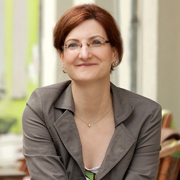Two premieres of works by Charlotte Seither were given at the MaerzMusik Festival in Berlin and the Villa Concordia Bamberg: Explorations and Crossing Boundaries with the Ensemble musikFabrik and PianoPercussion Berlin.
In Running circles for two pianos and two percussion, Charlotte Seither allows the dividing lines of the four instruments to blur into each other, so that a quartet of percussion instruments is created. The composer, who worked with a piano-percussion combination in Schwebende Verse, it less concerned with a superficial show of muscularity and more with a witty dialogue of sound colours as well the spatial interaction of the performers. What results is a quadrophonic game of gestures and signals: “Both groups of instruments, pianos and percussion, merge into a fractal intermixed sound space in which the resulting sounds cannot always be clearly attributed to piano or percussion. The piece is based on relatively reduced material which is dominated by upward-moving glissandi, repeatedly overlapping (“running circles”). Nonetheless the merging of the individual actions, of the overall blending together of lines and colours beyond the four instruments, plays an important role. The tonal sound seems in places to be almost electronic, although the sounds are only ever created acoustically.”
The play with a shift of perception, a kaleidoscoping or exchanging of the tonal arsenal becomes the compositional theme of Charlotte Seither’s Chercher le chien for seven instruments. An ensemble of bass flute, bass clarinet, trombone, violin, viola, cello and piano first develops a discourse over a trombone glissando. But gradually, the tonal scene shifts and changes imperceptibly, yet inexorably into noise. At the end come washes of rasping, rattling sonorities produced by four doubling instruments. The instruments leave one musical texture with quite subtle, soft transitions, and a new scene is gradually revealed. This new tonal space appears static, yet is created from the tiniest atomic movements. “This virtuosity at the micro-level interests me. The further away I am from the sound field, the more static is the impression, but little by little, the ear discovers these tiny movements. At the end there is a warm, beautiful wash of sound with repeated patterns which are not merely ornamental. This surface is a relevant, formative part of the work”, says the composer.
Marie Luise Maintz
(translation: Elizabeth Robsinson)
(aus [t]akte 1/2014)



